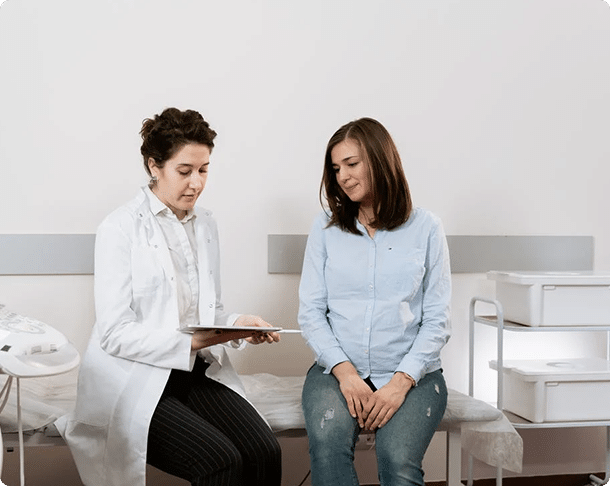Gestational Diabetes
A woman who develops diabetes after getting pregnant when she wasn’t diagnosed with the condition before pregnancy is diagnosed with gestational diabetes, sometimes called gestational diabetes mellitus (GDM). Pregnant women may develop the condition with one or all of their pregnancies.
Home > Pregnancy Complications > Gestational Diabetes
- Last Updated Date: March 24, 2025
Women’s health care teams usually test for gestational diabetes between 24 and 28 weeks because the condition tends to develop in the middle of pregnancy. Testing for the condition is necessary because many women experience only minor or barely noticeable symptoms, and ignoring the problem may result in health problems during pregnancy or birth.
What Causes Gestational Diabetes?
When a woman’s body cannot make enough insulin during pregnancy to compensate for natural hormonal changes, she may develop gestational diabetes. Healthy pregnant bodies make extra hormones to sustain the pregnancy, but sometimes a woman’s body cannot produce enough insulin to deal with the resulting buildup of glucose in the blood, which leads to a condition known as insulin resistance.
The pancreas must produce insulin to deal with the buildup of glucose. Since pregnancy increases the level of glucose in the blood by an impressive amount, some women develop gestational diabetes when their bodies can’t compensate for the change.
All pregnant women will experience some level of insulin resistance by the end of their pregnancy, but sometimes, a woman’s body cannot produce enough insulin to deal with these otherwise natural hormone changes.
Risk Factors for Gestational Diabetes
The National Institute of Diabetes and Digestive and Kidney Diseases, which is part of the National Institutes of Health (NIH), indicates that obesity and being overweight may increase the risk of developing gestational diabetes.
In addition, a woman who gains weight quickly during pregnancy may develop gestational diabetes. Women diagnosed in past pregnancies also have a significant chance of developing it in successive pregnancies.
Other risk factors include having immediate family members diagnosed with Type 2 diabetes, being over the age of 25 when the pregnancy begins, or being diagnosed with prediabetes before the pregnancy. Giving birth to a baby that weighs more than nine pounds or experiencing a stillbirth may also increase the chances of gestational diabetes.
Some races, including African Americans, Hispanics, Native Americans, and Pacific Islanders, have higher rates of developing gestational diabetes.
Certain health conditions may increase the risk for gestational diabetes, for example, polycystic ovary syndrome (PCOS).



Signs and Symptoms of Gestational Diabetes
Not all women will experience symptoms when they have gestational diabetes, which is why prenatal care should include a blood test for the disease. Some minor signs a woman might experience include increased thirst and more frequent urination.
Other signs and symptoms of the condition include fatigue, nausea, and vomiting; however, those conditions can also be present in women who don’t have gestational diabetes. Blurred vision, unexplained weight loss despite eating enough food, and yeast infections are other symptoms.
Testing for gestational diabetes is important even if a woman isn’t at greater risk for it because she is a healthy weight, does not have a family history of the condition, and maintains a healthy diet.
Getting Tested for Gestational Diabetes
During a woman’s regular checkup with her obstetrician, the doctor or a nurse will administer an oral glucose tolerance test (OGTT), which requires the woman to fast for eight hours before her appointment. The health care professional will draw blood, then the woman will drink a liquid that contains glucose.
Over the next two to three hours, the nurse or doctor will continue to draw blood each hour to confirm a diagnosis of gestational diabetes. High blood glucose levels over the course of the testing may indicate the disease.
How Does Gestational Diabetes Affect the Baby?
According to data from the Centers for Disease Control and Prevention (CDC), poorly controlled diabetes may result in a baby that grows very large because the condition allows too much feeding to occur while the baby is in utero.
Large babies delivered vaginally may have a higher risk of nerve damage because of added pressure on the baby’s shoulders during birth.
A large baby may also cause an uncomfortable pregnancy for the woman as well as make it more likely for a C-section to be required for delivery. A cesarean birth usually means additional recovery time for the mother.
What Are the Negative Effects of Gestational Diabetes?
Short-term effects of gestational diabetes on the baby’s health include low blood sugar at the time of birth, breathing problems, jaundice, and a low calcium level. For the mother, gestational diabetes may cause preeclampsia, early delivery, and high blood pressure.
Data published by the Journal of Maternal-Fetal Medicine suggests that gestational diabetes may lead to some long-term maternal or fetal problems. Mothers may have an increased risk for cardiovascular disease, cancer, or chronic kidney disease in the years after they become pregnant and give birth.
For the children born of mothers who develop gestational diabetes, the condition may also result in obesity, altered neurocognitive development, and insulin resistance. The study indicates that these problems could occur across all races and aren’t more significant in one population.
Can You Get Rid of Gestational Diabetes While Pregnant?
Women diagnosed with gestational diabetes while pregnant usually see the condition disappear after they give birth, and their blood sugar levels return to normal. Also, most women can experience otherwise normal pregnancies despite the diagnosis. Symptoms will often manifest as very mild, if at all.
The American Diabetes Association indicates that almost 10 percent of pregnant women will receive a diagnosis of gestational diabetes. After diagnosis, the main goal is living with the disease and maintaining a healthy pregnancy rather than trying to reverse it. Regular testing of blood sugar levels reduces the risk of complications during pregnancy because it can help women make good food choices and avoid high blood sugar.

What Are the Best Ways to Manage Gestational Diabetes?
Unless a health care professional recommends that a pregnant woman restrict her activities or go on bed rest, exercising regularly is important for living with gestational diabetes while pregnant. Exercise is essential in any case, but it is one of the best options for women to maintain healthy insulin activity in their bodies while pregnant.
According to an article published by Harvard Health Publishing, physical activity helps lower blood glucose levels and improve insulin sensitivity. Walking four hours a week is linked to a 40 percent lower risk of heart disease for women with diabetes. Walking was helpful for all types of diabetes, not just gestational diabetes.
During a prenatal visit, a woman may want to ask her health care provider about the best exercise therapies for living with gestational diabetes based on her personal history of exercise. Women whose bodies are already conditioned for activity may continue exercising throughout their pregnancies.
What Is the Best Gestational Diabetes Diet?
In addition to exercise, adopting a healthy diet that includes whole grains and restricts simple carbohydrates may lower pregnancy complications related to gestational diabetes. Healthy food not only provides the best nutrition for the fetus but also helps women maintain healthy weight gain during pregnancy.
One helpful way to maintain healthy blood sugar levels is to make sure there are options for healthy meals, even at a moment’s notice. Creating a list of healthy, simple foods to eat will help avoid blood sugar spikes and diabetic complications.
Doctors from Cedars Sinai indicate that a healthy diet means eating the right balance of protein, carbohydrates, and fats. The assumption that women should simply cut out carbohydrates isn’t always correct. Pregnant women benefit from and need carbohydrates, which means the point of a healthy gestational diabetes diet is to eat in a balanced manner rather than a highly restrictive one.
Living with Gestational Diabetes

When a woman becomes pregnant and is at risk for gestational diabetes, it is essential to keep in touch with a doctor throughout the pregnancy and develop healthy eating and exercise plans to reduce the chances of complications.
Gestational diabetes care might not require insulin shots; many women can deal with the condition solely through diet and exercise. However, it is best to remain in contact with a health care professional to keep an eye on the condition until it is time to give birth.

Written by:
Birth Injury Center Team
The Birth Injury Center aims to create informational web content and guides to help women and their families seeking support and guidance for birth injuries caused by medical negligence. All of the content published across The Birth Injury Center website has been thoroughly investigated and approved by medical expert Natalie Speer, RNC-OB.

